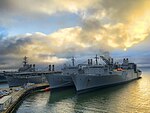Alameda Naval Air Museum
Aerospace museums in CaliforniaCommons category link is the pagenameMilitary and war museums in CaliforniaMuseums in Alameda County, California

The Alameda Naval Air Museum is an aviation museum located in Alameda, California and focused on the history of Naval Air Station Alameda.
Excerpt from the Wikipedia article Alameda Naval Air Museum (License: CC BY-SA 3.0, Authors, Images).Alameda Naval Air Museum
Pan Am Way, Alameda
Geographical coordinates (GPS) Address Website External links Nearby Places Show on map
Geographical coordinates (GPS)
| Latitude | Longitude |
|---|---|
| N 37.7814 ° | E -122.2992 ° |
Address
Alameda Naval Air Museum
Pan Am Way 2151
94607 Alameda
California, United States
Open on Google Maps








